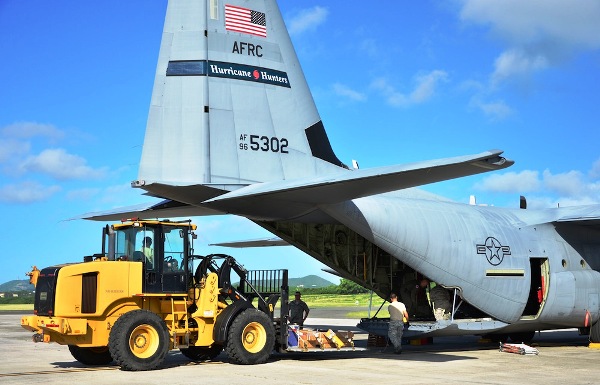
Every May, the 53rd Weather Reconnaissance Squadron known as Hurricane Hunters begin to watch the Atlantic and Caribbean Sea for tropical storms or hurricane formation, according to Lt. Col. Jon Talbot, the current mission commander.
Since they are informed about the weather, the crew can be ready in a few hours to fly to their base at the Henry E. Rohlsen Airport if a storm is brewing, Talbot said Friday.
Three WC-130J aircraft make the trip. From St. Croix the flight crews will take turns flying for eight or more hours directly into a storm.
Talbot described flying a mission into a hurricane as follows. “Some of the storms you fly are not bumpy. When it is intensifying or winding down it can be bumpy. But a category 3 is not that bad. Like a bumpy road, you drive slower,” Talbot said.
This year, the Hurricane Hunters flew to St. Croix to investigate two storms. Each trip included a crew of around 60 men and women, which included flight crew, mechanics and ground support. Talbot said generally three flight crews rotate and complete two, three or more missions a day, depending on the strength and proximity of the storm.
Usually the crews fly an average of 100 missions into tropical storms or hurricanes each season. This year there were only 34 flights because there were fewer than the average number of storms.
During the 2013 season, there were 13 named storms and two hurricanes – Ingrid and Humberto. According to the National Oceanic and Atmospheric Administration, in an average hurricane season, there are 12 named storms, six hurricanes and three hurricanes of Category 3 force or higher.
Source reporter Justin Shatwell flew with the Hurricane Hunters on a mission to investigate Tropical Storm Dorian.
When a storm is spawned, the Hurricane Hunters are activated by the National Hurricane Center, a branch of the U.S. Department of Commerce. NHC will call up the Hurricane Hunters, Air Force Reserve flight crews, from Keesler AFB when a storm is 24 hours from landfall or threatening the U.S. mainland.
The area or “sphere of influence” covered by the Hurricane Hunters includes the eastern Atlantic, Caribbean, the Gulf of Mexico and the U.S. mainland. They don’t fly into the western Pacific, Talbot said, but data often is shared with other countries.
The flight of the Hurricane Hunters, as it progresses, can be followed at www.tropicalatlantic.com
Operating the St. Croix base costs taxpayers $25 million a year, Talbot said. In return, the squadron can save many more millions of dollars in lost property, agriculture, economy and lives. Talbot said the cost to activate a city or state’s emergency management program, including evacuations, can cost up to $193 million. Timely weather data sent to NHC by the Hurricane Hunters can reduce the cost of the storm by $1 million a mile, according to Talbot.
The instrument that transmits crucial information, a dropsonde, is a multi-tasking instrument with a 16-inch metal cylinder and a parachute at one end. After it is launched from the plane, the dropsonde provides essential information about a storm gathered from the surface of the sea. Wind speed and direction, air pressure, temperature and humidity data are collected and transmitted to the National Hurricane Center.
When research indicates that a hurricane has traveled to the waters around Cuba or Cancun, it is two or three days from landfall, Talbot said, and the weather data becomes crucial. U.S cities need time to prepare and evacuate thousands or millions of residents if necessary.
Talbot said it takes three days to evacuate just the residents from Key West, Fla., because there is only one route.
In between storms, the Hurricane Hunters return to Mississippi. At the end of the season, they pack up airplane parts, tools and other equipment and fly the planes to Keesler AFB.
On Sunday, Talbot and the remaining crew members will leave their St. Croix base with 12 pallets of cargo. Instead of making several trips, one huge C17 transport will transport everything.
Talbot, with more than 40 years of service and an officer who interviews prospective squad members, said there are rarely openings for new members. This year, one or two applicants may be selected to join the Hurricane Hunters. Qualifications include being able to multi-task and get along with people, Talbot said.
“We look for someone who is pretty confident. You have to be a Type A personality, directive in what you’re doing. You have to work with other people and the environment changes pretty quickly,” he said.






